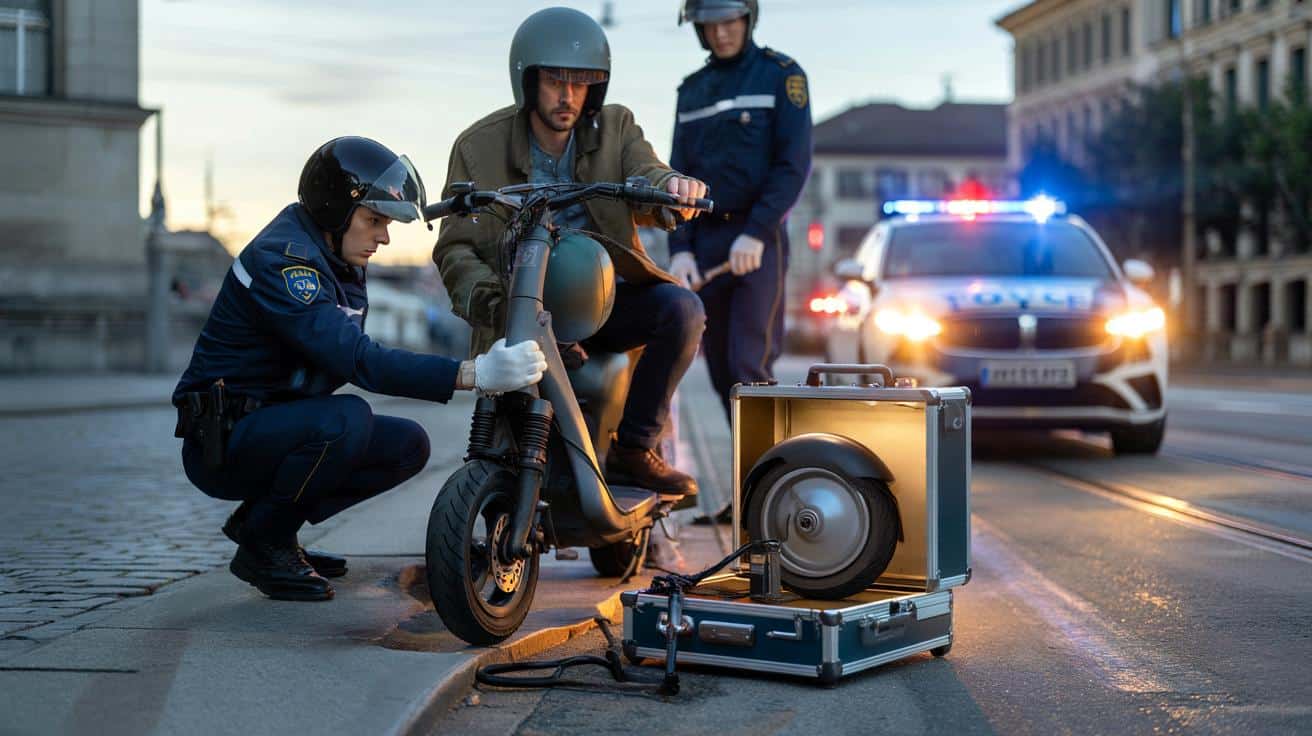A compact, suitcase-sized dynamometer has entered frontline policing in Zurich, promising quick roadside checks on e-bikes and e-scooters. The tool measures real top speed under load within minutes, and it is already exposing eye-watering figures far beyond legal limits.
A suitcase test at the kerb
Zurich State Police have demonstrated a portable dynamometer, built by Swiss firm Wenger, that lets officers roll an e-scooter or e-bike onto a small roller, spin the driven wheel, and read a verified maximum speed on a digital display. No lab, no track, no workshop—just a stable bit of pavement.
In one recent roadside check, officers recorded an e-scooter capable of roughly 110 km/h (68 mph). That stands against Switzerland’s legal cap for e-scooters on public roads: 20 km/h (12 mph). The mismatch illustrates how far some modified machines have drifted from their intended urban role.
From briefcase to verdict in minutes: a 60-second test, a rolling drum, and a readout that ends the argument at the kerb.
Police say they are finding more devices with derestricted controllers or plug-in “unlockers.” These kits remove factory speed limits and, in some cases, re-map acceleration. The result is a lightweight machine behaving like a motorbike—without number plates, insurance or a trained rider in proper kit.
How the briefcase dyno works
The unit acts like a mini rolling road. The drive wheel sits on a braked drum that simulates load. As the motor spins the wheel faster, the device measures rotational speed and calculates the vehicle’s top speed under controlled resistance. It is not a deep power test, but it is enough to prove if a scooter can exceed the legal threshold.
- Wheel is placed on the drum; the frame is stabilised.
- Throttle or pedal assist is engaged to reach maximum speed.
- The device logs peak speed under load and displays the result.
- Officers compare the readout with the legal limit for that category.
Compared with radar guns, which capture speed in motion, this tool reveals potential top speed even when the rider is stationary. It addresses a familiar defence: “I never ride that fast.” The device asks a different question—“how fast can it go?”—and then provides a number.
Why this matters to riders
Derestricted machines change the legal status of the vehicle and the responsibilities of the rider. A scooter capable of 68 mph is, by behaviour and risk profile, a motor vehicle. In many jurisdictions that means registration, a number plate, insurance, lighting and braking standards, and a proper helmet. It can also change where the vehicle may be used—cycle tracks, for instance, are not designed for motorcycle speeds.
Switzerland caps e-scooters at 20 km/h (12 mph). Zurich officers found one capable of about 110 km/h (68 mph).
There is also the matter of liability. If a collision occurs and the vehicle is found to exceed its legal category, insurers can refuse cover, leaving riders personally exposed to claims for injury or damage. Police can seize unlawfully modified machines and refer cases for prosecution.
The lure—and cost—of unlocking
Unlock kits promise faster commutes and “full motor potential,” often for modest money and a few taps in an app. They also invite cascading problems: brakes and tyres that were fine at 20–25 km/h run out of margin at 45 km/h, let alone 68 mph. Frames, stems and folding mechanisms can also face loads they were never designed to bear. Riders chasing speed gains often learn late that stopping distances and crash forces scale brutally with velocity.
What the rules look like in the UK and Europe
Rules vary, but the broad picture is consistent: slow, assisted cycling is treated like a bicycle; anything faster or self-propelled is treated like a motor vehicle.
- UK e-bikes (EAPCs): 250 W continuous rated motor, pedal-assist only, assist cuts at 15.5 mph (25 km/h). No registration or insurance required.
- UK e-scooters: private scooters are not lawful on public roads or pavements; rental trials limit speed to about 15.5 mph with compulsory insurance through the operator.
- EU e-bikes (EPACs): 250 W, assist to 25 km/h. Faster “speed-pedelecs” up to 45 km/h require registration, insurance, type approval and a suitable helmet.
- Switzerland: e-scooters allowed up to 20 km/h; higher-performing devices fall into moped or motorcycle classes with stricter requirements.
| Territory | E-scooter public limit | E-bike (standard) limit | Notes |
|---|---|---|---|
| UK | Rental ~15.5 mph; private not lawful on roads | 25 km/h, 250 W, pedal-assist | Speed-pedelecs need registration and insurance |
| EU (typical) | 20–25 km/h, city-by-city variation | 25 km/h, 250 W, pedal-assist | 45 km/h class treated as mopeds |
| Switzerland | 20 km/h | 25 km/h (standard), 45 km/h (S-pedelec category) | Higher classes require plates, insurance, equipment |
Could this briefcase land in Britain?
It would not be a surprise. UK police already use handheld decibel meters and roadside vehicle exam kits. A portable dyno adds a simple way to substantiate unlawful modification without a chase or a workshop visit. Procurement will come down to cost, training and evidential standards. If the device’s calibration and usage protocols stand up in court, it offers a neat complement to radar: one proves current speed, the other proves capability.
For busy urban teams, the appeal is clear: a kerbside test that turns suspicion into a number, then a decision. Expect to see similar technology at targeted operations near parks, promenades and city centres, especially where complaints about fast scooters are frequent.
If you are stopped
Riders usually face a short sequence of checks. Officers will ask for identification and may inspect the machine for a plate, a compliance label and a serial number. If the scooter looks altered, a dyno test can follow. A high readout can trigger seizure for further examination. Riders can face penalty points attached to their driving licence, fines, and claims for riding without insurance. In serious cases, prosecutions go to court.
Practical ways to stay on the right side
- Leave limiters alone. If your scooter or e-bike was sold with a cap, ride within it on public roads.
- Check your mode. Many devices allow user modes; ensure the street-legal setting is active.
- Maintain brakes and tyres. Pads, discs and rubber must match your actual speeds and loads.
- Wear a proper helmet and visible gear. You are smaller and quieter than traffic expects.
- Know your local rules. A legal set-up in one city may be unlawful in the next.
- If you need higher speeds, consider a vehicle in the correct category with registration and insurance.
Speed, distance and risk: a quick reality check
At 20 km/h, you cover about 5.5 metres every second. Double the speed to 40 km/h and you double that to 11 metres per second. Human reaction time averages around one second. That means at 40 km/h you travel an extra car length before your fingers even touch the brake. Add wet leaves, a drain cover or a pedestrian’s sudden step, and the margin evaporates.
Braking distance rises steeply with speed. If your scooter stops from 20 km/h in 5 metres on dry tarmac, a similar set-up may need roughly four times that at 40 km/h, because kinetic energy scales with the square of speed. Those numbers explain why regulators set low caps for devices as light as a suitcase—and why roadside tools that expose true capability are gaining traction.
What this means for the next ride
Expect more roadside checks in cities where rider complaints and near-misses stack up. A briefcase dyno takes the debate out of the equation and puts numbers in the officer’s notebook. For law-abiding riders, that could mean calmer shared paths and fewer hot-rodded missiles weaving past pushchairs. For anyone tempted by an unlock code, it is a reminder that a few extra kilometres per hour can trigger a very expensive conversation.
If you rely on micromobility for commuting, think about your use case. If you genuinely need 45 km/h, look at a speed-pedelec with the right licence, insurance and lighting, and plan routes on the carriageway. If you mainly hop across town on cycle lanes, the legal 20–25 km/h class remains the sweet spot for safety, cost and social acceptance.









How accurate is this briefcase dyno in court? Does calibratoin get checked regularly, and do tyre pressure, wheel size, battery state or firmware tweeks skew the readout? Seems like lots of variables for a roadside verdict.